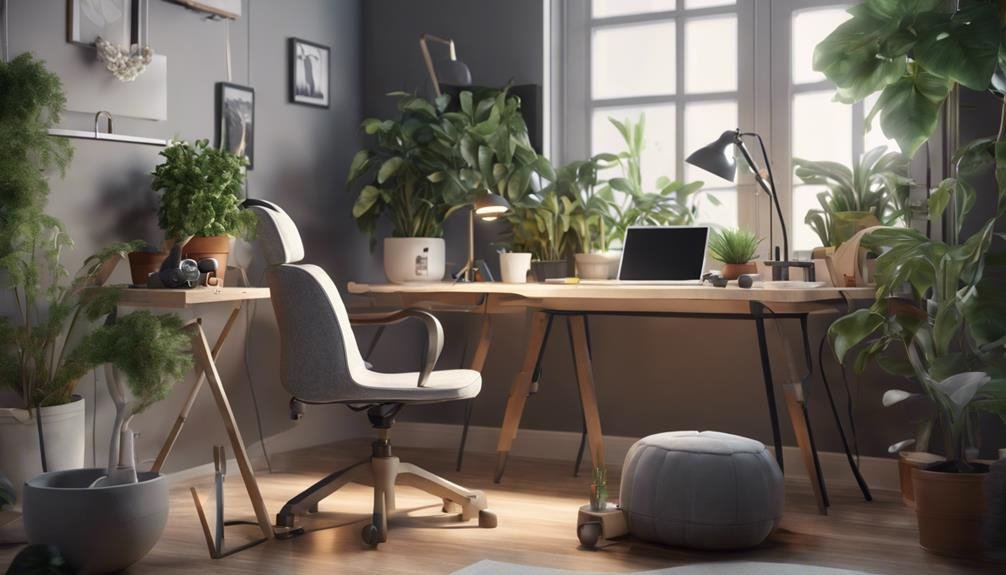Creating Your Ideal Workspace: Tailoring Your Environment for Neurodiverse Success
|
Getting your Trinity Audio player ready...
|
To tailor your ideal workspace for neurodiverse success, cater to your unique cognitive and sensory needs. Adjust lighting and noise levels to suit your preferences. Customize your desk setup for comfort and productivity. Consider standing desks or ergonomic chairs. Personalize with calming elements like nature-inspired decor or aromatherapy. Implement organizational systems and efficient routines. Prioritize your well-being and enhance your focus with strategic design elements. Find ways to optimize your environment to support your success.
Key Takeaways
- Customize lighting and sensory design for individual needs.
- Implement ergonomic workspace considerations for physical well-being.
- Utilize efficient organizational systems for task management.
- Incorporate calming elements like nature-inspired decor and aromatherapy.
- Establish a productive routine with structured schedules and breaks.
Understanding Neurodiversity Traits
To truly create your ideal workspace for neurodiverse success, it's essential to first understand the unique traits of neurodiversity that individuals may possess. Cognitive flexibility is a key trait found in many neurodiverse individuals, allowing for a varied and adaptable approach to problem-solving and creativity. Embracing this flexibility can lead to innovative solutions and a dynamic work environment that nurtures neurodiverse strengths.
Sensory sensitivities are another vital aspect to take into account. Many neurodiverse individuals may experience heightened sensitivity to stimuli such as light, sound, touch, or smell. By acknowledging and accommodating these sensitivities, you can create a workspace that minimizes distractions and promotes a more comfortable and focused atmosphere. This could involve using noise-canceling headphones, adjusting lighting levels, providing fidget toys, or creating quiet zones.
Ergonomic Considerations for Comfort
Considering the importance of creating a comfortable and supportive workspace for neurodiverse individuals, ergonomic considerations play a significant role in enhancing productivity and well-being. To guarantee ideal comfort, start by making chair adjustments to support your posture and reduce physical strain. Utilize desk accessories like wrist rests or footrests to promote proper alignment and comfort during long work sessions.
Monitor placement is essential for reducing eye strain and neck discomfort. Position your monitor at eye level to minimize the need for tilting your head up or down. Adjust the brightness and contrast settings to suit your visual comfort. Additionally, maintain an appropriate keyboard height to prevent wrist strain. Ensure your keyboard is positioned at a height that allows your elbows to stay close to your body and your wrists to remain straight.
Personalizing Your Workspace Setup
When it comes to personalizing your workspace setup, consider the impact of ergonomic furniture selection and customized lighting options. These elements can greatly enhance your comfort and productivity throughout the day.
Ergonomic Furniture Selection
Enhance your workspace by carefully selecting ergonomic furniture that aligns with your unique needs and preferences, ensuring comfort and efficiency in your daily tasks.
When choosing furniture, consider the following:
- Standing Desks: Opt for a standing desk to reduce sedentary behavior, improve circulation, and boost energy levels throughout the day.
- Chair Ergonomics: Prioritize a chair that supports proper posture, with adjustable height and lumbar support to prevent back strain.
- Customizable Workstations: Look for furniture that offers flexibility in setup, allowing you to personalize your workspace to suit your specific requirements and comfort levels.
Customized Lighting Options
To optimize your workspace setup for neurodiverse success, explore tailored lighting solutions that cater to your specific sensory needs and enhance productivity. When designing your ideal workspace, consider the impact of natural vs. artificial lighting and the benefits of mood-enhancing bulbs. Natural light can help regulate your circadian rhythm and boost mood, while artificial lighting can be adjusted to reduce glare and create a consistent brightness level. Mood-enhancing bulbs, such as full-spectrum or color-changing lights, can positively influence your mental state and energy levels throughout the day. Experiment with different lighting options to find what works best for you and promotes a comfortable and productive environment.
| Natural Lighting | Artificial Lighting |
|---|---|
| Regulates Circadian Rhythm | Adjustable Brightness |
| Boosts Mood | Reduces Glare |
| Consistent Light Level | |
Sensory-Friendly Design Strategies
When creating your ideal workspace for neurodiverse success, consider the impact of color and lighting choices on your sensory experience.
Opt for comfortable furniture that promotes relaxation and focus, helping you feel at ease while you work.
Color and Lighting
Immerse yourself in a harmonious blend of soothing colors and gentle lighting to cultivate a sensory-friendly workspace that nurtures your neurodiverse strengths. When considering color and lighting for your ideal workspace, remember the principles of color psychology and the benefits of natural light. Here are key strategies to enhance your environment:
- Color Psychology:
Choose calming colors like soft blues, greens, or warm neutrals to create a serene atmosphere that promotes focus and relaxation.
- Natural Light:
Position your workspace near windows to maximize natural light, which can boost mood, energy levels, and overall well-being.
- Adjustable Lighting:
Incorporate adjustable lighting options such as dimmable overhead lights or task lamps to personalize your lighting based on your needs throughout the day.
Comfortable Furniture
Enhance your workspace with furniture designed for sensory comfort, prioritizing ergonomic support and tactile materials to create a calming and functional environment conducive to your neurodiverse needs.
Look for chairs with lumbar support and adjustable height features to maintain proper posture and reduce discomfort. Consider adding soft cushions to your seating area for added comfort and sensory input.
Footrest options can help improve circulation and provide additional sensory feedback. When selecting furniture, opt for textures that are soothing to the touch and visually pleasing.
Organizational Systems for Efficiency
To optimize your work environment, consider implementing streamlined organizational systems that cater to your unique workflow and preferences. Building a workspace that supports your neurodiversity involves creating structures that enhance your productivity and comfort. Here are some strategies to help you achieve efficiency:
- Digital Organization: Utilize apps or software that can assist in organizing your tasks, documents, and schedules. Digital tools can help you keep track of deadlines, set reminders, and manage your workload effectively.
- Time Management: Implement techniques like the Pomodoro method to break down work into intervals, allowing for focused bursts of productivity followed by short breaks. Time blocking can also help schedule specific tasks during set periods, optimizing your workflow.
- Customized Workflow: Tailor your organizational system to fit your individual needs. Whether it's color-coding, using physical organizers, or creating a personalized filing system, find what works best for you to maintain order and clarity in your workspace.
Lighting and Acoustics Optimization
Consider adjusting the lighting and acoustics in your workspace to create an environment that maximizes your focus and comfort. Essential light plays a significant role in boosting mood and productivity. Position your desk near windows to benefit from natural light, reducing eye strain and enhancing your overall well-being. If access to essential light is limited, consider investing in full-spectrum light bulbs that mimic natural light to create a similar effect.
Soundproofing solutions can help minimize distractions and create a calmer work environment. Add sound-absorbing materials like rugs, curtains, or acoustic panels to reduce echoes and dampen noise. Noise-canceling headphones are also a great option to block out unwanted sounds and help you concentrate better. Experiment with different setups to find what works best for you, whether it's a quiet space or soft background music to mask disruptive noises.
Incorporating Calming Elements
To create a more relaxing workspace tailored to your needs, introduce calming elements that promote a sense of tranquility and focus. Incorporating these elements can help you create a space that enhances your well-being and productivity.
- Nature Inspired Decor: Bringing elements of nature into your workspace, such as plants, nature-themed artwork, or natural materials like wood, can have a soothing effect on your mind and body.
- Aromatherapy Essentials: Consider using essential oils or a diffuser with scents like lavender, chamomile, or eucalyptus to create a calming atmosphere that can help reduce stress and anxiety.
- Cozy Textiles: Introduce soft blankets, cushions, or rugs made from cozy textiles like fleece or faux fur to add warmth and comfort to your workspace, making it a more inviting and relaxing environment.
Creating a Productive Routine
Developing a consistent and structured routine can greatly boost your productivity and overall success in your workspace. To maximize your efficiency, consider incorporating practices like morning meditation and digital detox into your daily schedule. Morning meditation can help clear your mind, improve focus, and set a positive tone for the day ahead. Likewise, a digital detox can reduce distractions, enhance creativity, and prevent burnout.
| Morning Meditation | Digital Detox |
|---|---|
| – Clears your mind | – Reduces distractions |
| – Improves focus | – Enhances creativity |
| – Sets a positive tone | – Prevents burnout |
Conclusion
As you tailor your workspace to fit your unique needs, remember that your environment is like a canvas waiting to be painted with colors that bring out the best in you.
By incorporating personalized touches and thoughtful design strategies, you can create a space that not only supports your neurodiversity but also enhances your productivity and well-being.
Embrace the power of your surroundings to cultivate a space that inspires and uplifts you on your journey towards success.








